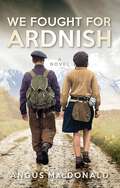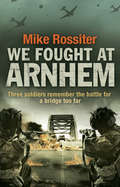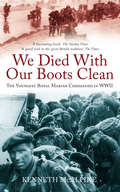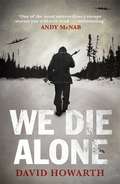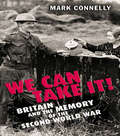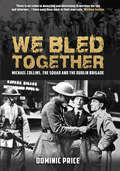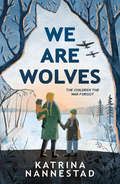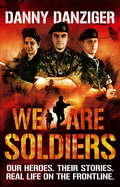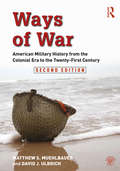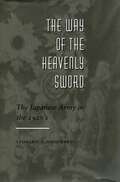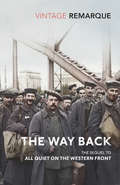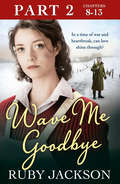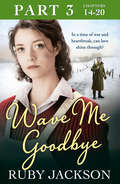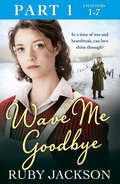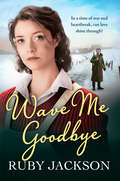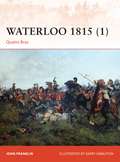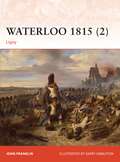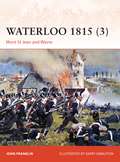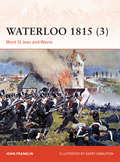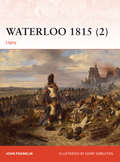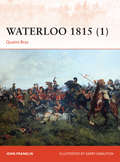- Table View
- List View
We Fought for Ardnish: A Novel - The sequel to the bestselling Ardnish Was Home (Ardnish Ser. #2)
by Angus MacDonaldAfter joining the the Lovat Scouts at the outbreak of the Second World War Donald Angus Gillies is sent on a mission to the Alps, where he meets Francoise, a young French Canadian SOE agent. The pair immediately form a close bond, but when Francoise is injured and captured, DA realizes his feelings for her are much, much stronger. After desperate attempts to find her, he has given up all hope. But a posting to Canada leads to some remarkable news, not just about Francoise but also about his own family.Reunited once more, Donald Angus and Francoise plan to live together in his beloved Ardnish, but have one further mission to complete first – a mission more dangerous than anything they have ever faced before . . .
We Fought at Arnhem
by Mike RossiterOperation Market Garden: a plan to capture the bridge over the Rhine at Arnhem and outflank the German front. In all twelve thousand airborne troops were to land, either by parachute or glider, at three drop zones and move towards their objective. As the world now knows the mission was to be 'a bridge too far' for the British forces. Mike Rossiter has interviewed three of the survivors of those fateful days, each involved in a different flank of the British attack, and in vivid detail reconstructs the events that lead up to this most famous of glorious defeats. It is at once a story of hubris and bad planning, but also of valiant sacrifice and inspirational courage.
We Don't Become Refugees by Choice: Mia Truskier, Survival, and Activism from Occupied Poland to California, 1920-2014 (Palgrave Studies in Oral History)
by Teresa A. MeadeThis book traces the life of Maria Mia Truskier, who fled the Nazis as a young Polish Jew in early 1940 and once safely resettled in the United States, became an activist for other refugees, earning renown in the Bay Area as “the oldest refugee” of the East Bay Sanctuary Covenant. Mia worked for decades assisting those fleeing from war, violence and hardship, mainly from Central America and Haiti. Based on extensive interviews with Truskier before she passed away, as well as memorabilia from her own lifetime, including coded letters, newspaper clippings, and old photographs, this book results in a complex and multi-layered oral history. As Mia drew on memories of her life in Europe and World War II, she was situating and constructing those memories while re-reading and discovering these artifacts alongside the author of this book, and ultimately relating the ways that she and her family years later sought to make a difference for other refugees, drawing a connection between two major eras of human displacement: the end of World War II and today.
We Died With Our Boots Clean: The Youngest Royal Marine Commando in WWII (History Press Ser.)
by Kenneth McAlpineAt the age of seventeen, Kenneth McAlpine ran away from the Repton school to join Churchill's new elite special force, the Royal Marine Commandos. As the youngest member of the youngest commando force, after three months he found himself fighting on the beaches of Normandy. In We Died With Our Boots Clean, McAlpine tells his own unique story of World War II and his highly eventful military career. From an unusual encounter with Montgomery and Patton, a concerted attempt to kill a sergeant major and his best friend’s arrest for swearing at the Queen of Holland, McAlpine paints a fascinating picture of commando life and the harsh training that prepared soldiers for frontline combat in an elite unit. Full of absorbing anecdotes such as his time in a military prison and a rescue operation at a concentration camp, this book is an essential part of a World War II enthusiast’s library.
We Die Alone: A Wwii Epic Of Escape And Endurance (Lyons Press Ser.)
by David HowarthIn March 1943 a team of expatriate Norwegian commandos sailed from the most northerly part of Britain for Nazi-occupied Norway. Their mission was to organise and support the Norwegian resistance. They were betrayed, and only one man survived the ambush by the Nazis. Crippled by frostbite, snow-blind and hunted by the Nazis, Jan Baalstrud managed to find a tiny arctic village. There - delirious, near death - he found villagers willing to risk their own lives to save him. David Howarth narrates his incredible escape in this gripping tale of courage and the resilience of the human spirit.
We Can Take It!
by Mark Connelly`We Can Take It!' shows that the British remember the war in a peculiar way, thanks to a mix of particular images and evidence. Our memory has been shaped by material which is completely removed from historical reality. These images (including complete inventions) have combined to make a new history. The vision is mostly cosy and suits the way in which the Britons conceive of themselves: dogged, good humoured, occasionally bumbling, unified and enjoying diversity. In fact Britons load their memory towards the early part of the war (Dunkirk, Blitz, Battle of Britain) rather than when we were successful in the air or against Italy and Germany with invasions. This suits our love of being the underdog, fighting against the odds, and being in a crisis. Conversely, the periods of the war during which Britain was in the ascendant are, perversely, far more hazy in the public memory.
We Can Take It!
by Mark Connelly`We Can Take It!' shows that the British remember the war in a peculiar way, thanks to a mix of particular images and evidence. Our memory has been shaped by material which is completely removed from historical reality. These images (including complete inventions) have combined to make a new history. The vision is mostly cosy and suits the way in which the Britons conceive of themselves: dogged, good humoured, occasionally bumbling, unified and enjoying diversity. In fact Britons load their memory towards the early part of the war (Dunkirk, Blitz, Battle of Britain) rather than when we were successful in the air or against Italy and Germany with invasions. This suits our love of being the underdog, fighting against the odds, and being in a crisis. Conversely, the periods of the war during which Britain was in the ascendant are, perversely, far more hazy in the public memory.
We Bled Together: Michael Collins, The Squad and the Dublin Brigade
by Dominic PriceThere is no crime in detecting and destroying in wartime the spy and informer...I have paid them back in their own coin. - Michael CollinsMichael Collins' development of a formidable intelligence network transformed, for the first time in history, the military fortunes of the Irish against the British. The Dublin Brigade of the IRA was pivotal to this defining strategy. In 1919, Collins formed members of the brigade into two Special Duties Units. They eventually joined to form his 'Squad' of assassins tasked with immobilising British intelligence. Eyewitness testimonies and war diaries lend immediacy and insight to this thrilling account of the daring espionage and killings carried out by both sides on Dublin's streets. Dominic Price reveals how the IRA developed Improvised Explosive Devices, and experimented with chemical weapons in the form of poison gas and infecting water supplies.When the Civil War erupted, the devotion of a significant cohort of the Dublin Brigade to Collins, forged during the darkest of days, was unbreakable. Many of them, identified here for the first time, formed the backbone of the Free State in key intelligence and military roles. While not shying away from the revulsions of the Civil War, neither does Price abandon the brigade's story at its conclusion. As well as revealing the disenchantment of some, who took part in the 1924 army mutiny, he exposes the personal horrors that awaited in peacetime, when psychological trauma was common. This is the stirring and poignant story of the human endeavour and suffering at the core of the Dublin Brigade's fight for Irish freedom.
We Are Wolves
by Katrina NannestadA heartbreaking, untold story of World War II from award-winning Australian author Katrina Nannestad, perfect for 9+ readers and fans of Michael Morpurgo, Goodnight Mr Tom and I am David.
We Are Soldiers: Our heroes. Their stories. Real life on the frontline.
by Danny DanzigerWhat is it like to drive a Challenger tank over desert terrain for six days in a row? Or hover an Apache AH1 attack helicopter a hundred metres above enemy ground? How quickly can a Sapper clear a field of unexploded devices, or build a bridge - or blow one up? What is it like to fix bayonets, and engage in hand to hand combat, or train a 5.56 mm SA80 sniper sight on an enemy soldier, and pull the trigger? How do you find out what a soldier must learn on his way to war...? Ask him.In this extraordinary book, Danny Danziger interviews the people who fight our wars for us, providing a unique insight into the reality of what we ask of our armed forces. Groundbreaking and utterly compelling, WE ARE SOLDIERS takes the reader to the heart of the 21st century soldier's experience.
Ways of War: American Military History from the Colonial Era to the Twenty-First Century
by Matthew S. Muehlbauer David J. UlbrichFrom the first interactions between European and native peoples to the recent conflicts in Afghanistan and Iraq, military issues have always played an important role in American history. Now in its updated second edition, Ways of War comprehensively explains the place of the military within the wider context of the history of the United States, showing its centrality to American culture, economics, and politics. The fifteen chapters provide a complete survey of the American military's evolution that is designed for semester-length courses. Features of the revised and fully-updated second edition include: • Chronological and comprehensive coverage of North American conflicts in the seventeenth century and all wars undertaken by the United States; • New or expanded sections on Non-English Colonization in Northeast North America, the Beaver Wars, Pontiac’s War, causes of the American Revolution, borderlands conflict from 1848 to 1865, causes of the American Civil War, Reconstruction, the Meuse-Argonne Campaign, Barack Obama’s second term as president, the Syrian Civil War, and the rise of the Islamic State; • 50 revised maps, 20 new images, chapter timelines identifying key events, and text boxes providing biographical information and first-person accounts; • A companion website featuring a testbank of essay and multiple choice questions for instructors, as well as student study resources such as an interactive timeline, chapter summaries, annotated further readings, links to online resources, flashcards, and a glossary of key terms. Extensively illustrated and written by experienced instructors, the second edition of Ways of War remains essential reading for all students of American Military History.
Ways of War: American Military History from the Colonial Era to the Twenty-First Century
by Matthew S. Muehlbauer David J. UlbrichFrom the first interactions between European and native peoples to the recent conflicts in Afghanistan and Iraq, military issues have always played an important role in American history. Now in its updated second edition, Ways of War comprehensively explains the place of the military within the wider context of the history of the United States, showing its centrality to American culture, economics, and politics. The fifteen chapters provide a complete survey of the American military's evolution that is designed for semester-length courses. Features of the revised and fully-updated second edition include: • Chronological and comprehensive coverage of North American conflicts in the seventeenth century and all wars undertaken by the United States; • New or expanded sections on Non-English Colonization in Northeast North America, the Beaver Wars, Pontiac’s War, causes of the American Revolution, borderlands conflict from 1848 to 1865, causes of the American Civil War, Reconstruction, the Meuse-Argonne Campaign, Barack Obama’s second term as president, the Syrian Civil War, and the rise of the Islamic State; • 50 revised maps, 20 new images, chapter timelines identifying key events, and text boxes providing biographical information and first-person accounts; • A companion website featuring a testbank of essay and multiple choice questions for instructors, as well as student study resources such as an interactive timeline, chapter summaries, annotated further readings, links to online resources, flashcards, and a glossary of key terms. Extensively illustrated and written by experienced instructors, the second edition of Ways of War remains essential reading for all students of American Military History.
The Way To A Soldier's Heart: The Way To A Soldier's Heart Nora's Guy Next Door This Baby Business Navy Seal Promise (Soldiers and Single Moms #2)
by Gina WilkinsA family for her daughter?
The Way of the Heavenly Sword: The Japanese Army in the 1920's
by Leonard A. HumphreysThis text examines the history of the Japanese army in the 1920s. In this decade, the 'Meija military system' disintegrated and was replaced by a new 'Imperial Army System'. The Japanese victory over Russia in 1905 had changed the direction of Japanese military thought from almost total dependence on western rational military thinking to a more traditional reliance on morale as the preponderant factor for victory in combat. The author focuses on the intense and complex struggle which took place over leadership of the Army, the application of the principle of the primacy of morale, and the quite contradictory but obvious necessity for the army to modernize. This internal turmoil was intensified by a background of increasingly difficult economic circumstances, and the terrible effects of the great earthquake and fire of 1923. This crucial decade of Japanese history set the stage for the shattering events of the 1930s and 1940s.
The Way Back
by Erich Maria RemarqueThe sequel to All Quiet on the Western Front, one of the most powerful novels of the First World War and a twentieth-century classic. After four gruelling years the survivors of the Great War finally make their way home. Young, spirited Ernst is one. Finding himself inexplicably returned to his childhood bedroom, restless, chafing, confused, he knows he must somehow resurrect his life. But the way back to peace is far more treacherous than he ever imagined. If All Quiet on the Western Front was a lament for a lost generation, this sequel speaks with the same resonant voice for those who came back.The is a new definitive English translation by expert Remarque translator Brian Murdoch. ‘Remarque is a craftsman of unquestionably first rank’ New York Times Book Review
Wave Me Goodbye (Part Two (Part Two (Part Two (Part Two: Chapters 8–13): Wave Me Goodbye
by Ruby JacksonWave Me Goodbye can be read either as a full length book or in 3 serialised eBook only parts.
Wave Me Goodbye (Part Three (Part Three (Part Three (Part Three: Chapters 14–20): Wave Me Goodbye
by Ruby JacksonWave Me Goodbye can be read either as a full length book or in 3 serialised eBook only parts.
Wave Me Goodbye (Part One (Part One (Part One (Part One: Chapters 1–7): Wave Me Goodbye
by Ruby JacksonWave Me Goodbye can be read either as a full length book or in 3 serialised eBook only parts.
Wave Me Goodbye: Wave Me Goodbye
by Ruby JacksonA compelling story of tragedy and triumph in WWII -the second in a series of books featuring four young women whose lives will be forever changed by the war.
Waterloo 1815: Quatre Bras (Campaign)
by Gerry Embleton John FranklinTo commemorate the 2015 bicentenary of the Battle of Waterloo, one of the defining campaigns in European History, Osprey is replacing its single volume Campaign title covering the whole of the battle with three highly detailed volumes. Based on new research drawn from unpublished first-hand accounts these volumes will provide a comprehensive resource for every aspect of the battle. The first of this trilogy details the battle of Quatre Bras where an initial 8,000 Allied troops faced 48,000 men of the French Armée du Nord under Marshal Ney. Realising his error, Wellington concentrated his troops at the strategic crossroads of Quatre Bras where they just managed to hold off Ney's attacks. The battle ended in a tactical stalemate but, unable to link up with Blücher's Prussians, Wellington retreated back along the road to Brussels to new positions at Waterloo. Featuring extensive photographs, full colour artworks, maps and bird's-eye-views, this first instalment is not to be missed.
Waterloo 1815: Ligny (Campaign)
by Gerry Embleton John FranklinThis title represents the second instalment of the captivating study of the Waterloo campaign, one of the defining events in European history. In particular it focuses on the desperate struggle for Ligny, which saw the Prussians pushed back by the French Army after heavy fighting in what was to be Napoleon's last battlefield victory. With Wellington unable to assist his Prussian allies in time, the Prussian centre was overwhelmed as night began to fall, although the flanks were able to retreat in some semblance of order. Stunning illustrations augment the drama of the fighting in this area while considerable new research drawn from unpublished first-hand accounts provide a detailed and engaging resource for all aspects of the battle.
Waterloo 1815: Mont St Jean and Wavre (Campaign)
by Gerry Embleton John FranklinWaterloo is one of the defining campaigns of European history. The name conjures up images of the terrible scale and grandeur of the Napoleonic Wars and the incredible combined effort that finally ended Napoleon's aspirations of power in Europe. Drawn from unpublished first-hand accounts, and using detailed illustrations, this comprehensive volume is the ideal resource for studying the intense fighting at the battles of Waterloo and Wavre, the final, decisive engagements of the Waterloo campaign. Those two battles are at the heart of this study, which explores the action at Mont St Jean where Wellington managed to hold the French at bay until the arrival of the Prussians under Blücher saw the Allies secure a hard-fought victory at the dramatic climax of the 'Hundred days'.
Waterloo 1815: Mont St Jean and Wavre (Campaign #280)
by Gerry Embleton Mr John FranklinWaterloo is one of the defining campaigns of European history. The name conjures up images of the terrible scale and grandeur of the Napoleonic Wars and the incredible combined effort that finally ended Napoleon's aspirations of power in Europe. Drawn from unpublished first-hand accounts, and using detailed illustrations, this comprehensive volume is the ideal resource for studying the intense fighting at the battles of Waterloo and Wavre, the final, decisive engagements of the Waterloo campaign. Those two battles are at the heart of this study, which explores the action at Mont St Jean where Wellington managed to hold the French at bay until the arrival of the Prussians under Blücher saw the Allies secure a hard-fought victory at the dramatic climax of the 'Hundred days'.
Waterloo 1815: Ligny (Campaign #277)
by Gerry Embleton Mr John FranklinThis title represents the second instalment of the captivating study of the Waterloo campaign, one of the defining events in European history. In particular it focuses on the desperate struggle for Ligny, which saw the Prussians pushed back by the French Army after heavy fighting in what was to be Napoleon's last battlefield victory. With Wellington unable to assist his Prussian allies in time, the Prussian centre was overwhelmed as night began to fall, although the flanks were able to retreat in some semblance of order. Stunning illustrations augment the drama of the fighting in this area while considerable new research drawn from unpublished first-hand accounts provide a detailed and engaging resource for all aspects of the battle.
Waterloo 1815: Quatre Bras (Campaign #276)
by Gerry Embleton Mr John FranklinTo commemorate the 2015 bicentenary of the Battle of Waterloo, one of the defining campaigns in European History, Osprey is replacing its single volume Campaign title covering the whole of the battle with three highly detailed volumes. Based on new research drawn from unpublished first-hand accounts these volumes will provide a comprehensive resource for every aspect of the battle. The first of this trilogy details the battle of Quatre Bras where an initial 8,000 Allied troops faced 48,000 men of the French Armée du Nord under Marshal Ney. Realising his error, Wellington concentrated his troops at the strategic crossroads of Quatre Bras where they just managed to hold off Ney's attacks. The battle ended in a tactical stalemate but, unable to link up with Blücher's Prussians, Wellington retreated back along the road to Brussels to new positions at Waterloo. Featuring extensive photographs, full colour artworks, maps and bird's-eye-views, this first instalment is not to be missed.
